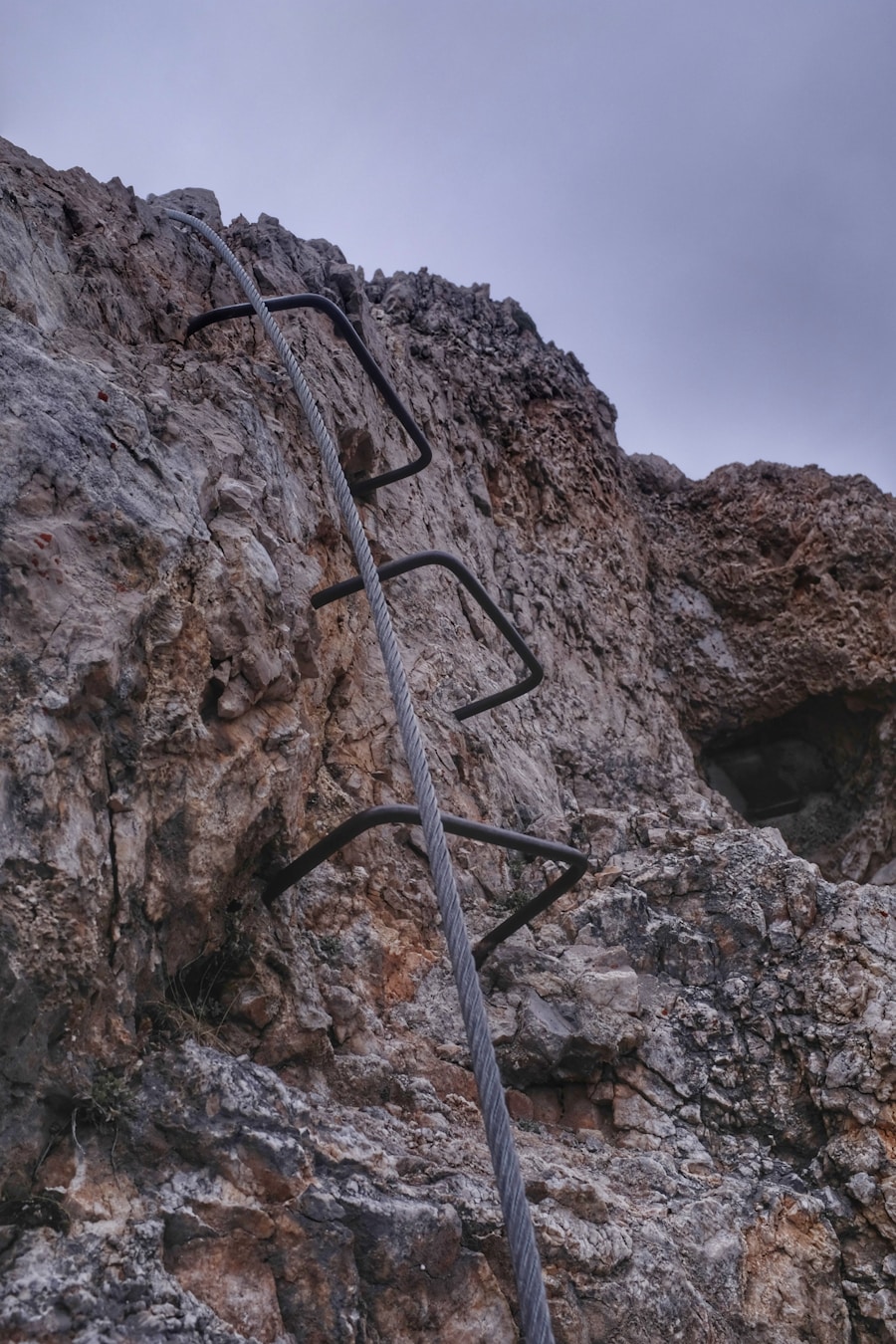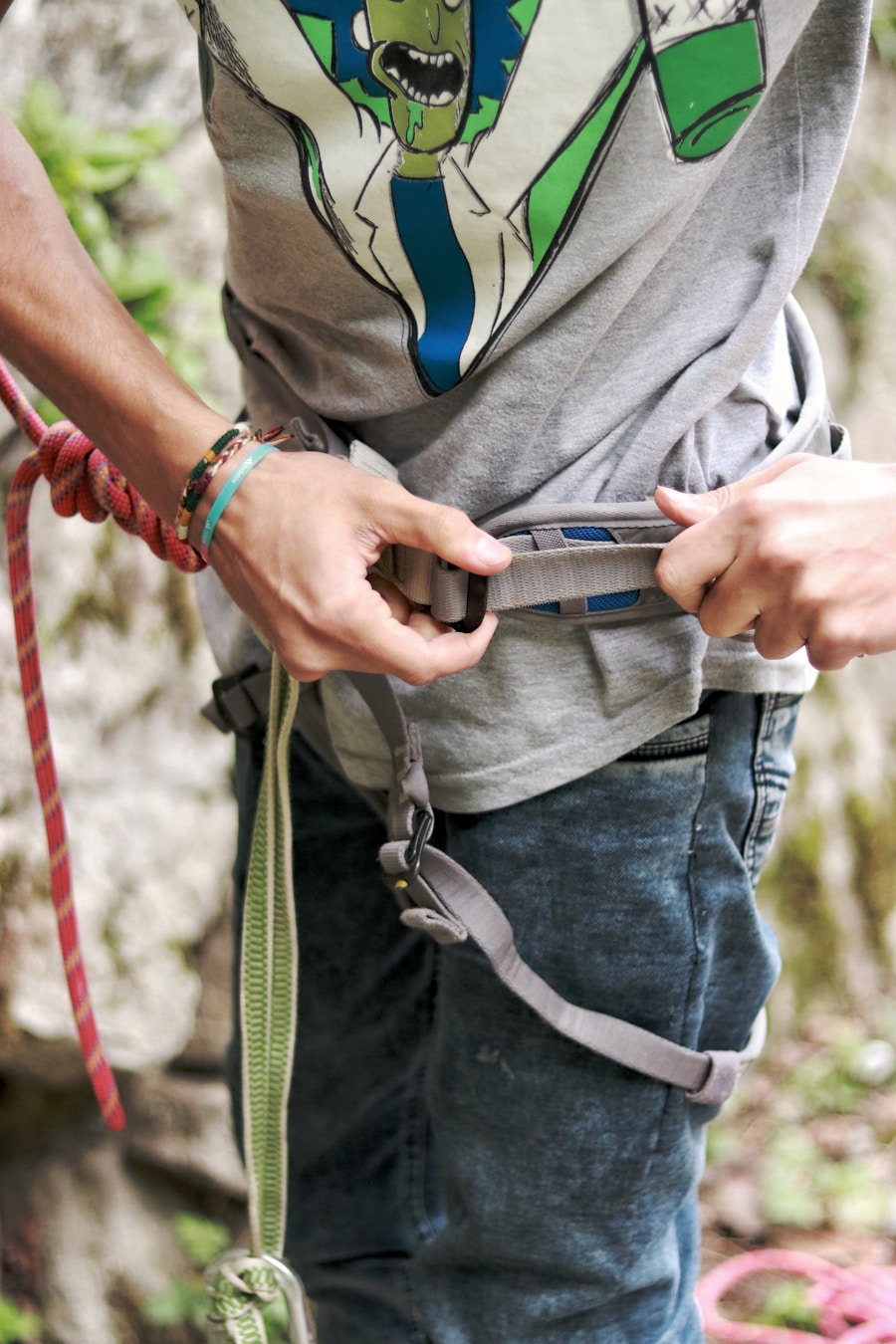Hiking poles have become an essential piece of equipment for outdoor enthusiasts, providing stability, support, and balance on various terrains. However, the benefits of hiking poles can only be fully realized when they are properly adjusted to fit the user’s height and the specific conditions of the hike. When hiking poles are set to the correct length, they can help distribute weight more evenly across the body, reducing strain on the knees and joints.
This is particularly important during long hikes or when traversing steep inclines and declines, where the risk of injury can increase significantly. Moreover, properly adjusted hiking poles can enhance overall hiking efficiency. When poles are at the right height, they allow for a natural arm swing that complements the rhythm of walking.
This not only aids in maintaining balance but also helps in propelling the hiker forward, making it easier to cover longer distances without excessive fatigue. The psychological benefits should not be overlooked either; knowing that your equipment is optimized for your body can boost confidence and encourage a more enjoyable hiking experience.
Key Takeaways
- Properly adjusted hiking poles can provide stability, reduce impact on joints, and improve overall hiking experience.
- Finding the right length for your hiking poles is crucial for maintaining proper posture and maximizing efficiency.
- Adjusting the wrist straps to the correct length and position can provide maximum comfort and support during long hikes.
- Setting the correct angle for the poles’ tips can improve traction and stability on different terrains.
- Fine-tuning the grips of your hiking poles is essential for a secure and comfortable hold, especially during challenging hikes.
Finding the Right Length for Your Hiking Poles
Determining the correct length for hiking poles is crucial for maximizing their effectiveness. A general rule of thumb is to adjust the poles so that when you stand upright and hold them, your elbows form a 90-degree angle. This position allows for optimal leverage and support while walking.
For those who prefer a more precise measurement, many manufacturers provide specific guidelines based on height. For instance, a person who is 5 feet 6 inches tall might find that poles measuring around 110 centimeters are ideal, while someone who stands at 6 feet may require poles closer to 125 centimeters. However, personal preference plays a significant role in this adjustment process.
Some hikers may prefer slightly longer poles for added reach on steep ascents or shorter poles for better control on descents. It’s also worth considering the type of terrain you’ll be navigating; if you anticipate a mix of flat trails and steep climbs, having adjustable poles can be particularly beneficial. This versatility allows hikers to adapt their equipment to changing conditions, ensuring that they maintain comfort and efficiency throughout their journey.
Adjusting the Wrist Straps for Maximum Comfort and Support

Wrist straps are often an overlooked component of hiking poles, yet they play a vital role in providing support and comfort during hikes. Properly adjusted wrist straps can help distribute the weight of the poles across the wrist and forearm, reducing fatigue and allowing for a more natural grip. To adjust the straps correctly, slide your hand through the loop from underneath, allowing the strap to rest against your palm.
Once your hand is in place, tighten the strap so that it feels snug but not restrictive; you should be able to release your grip on the pole without dropping it. In addition to comfort, wrist straps can enhance stability when navigating uneven terrain. When descending steep slopes or crossing rocky paths, having your hands secured in the straps allows you to exert more force without worrying about losing your grip on the pole.
This added security can be particularly beneficial in challenging conditions where maintaining balance is crucial. Regularly checking and adjusting these straps throughout your hike ensures that they remain effective and comfortable as you move through different environments.
Setting the Correct Angle for the Poles’ Tips
| Tips | Angle |
|---|---|
| Use a Level | 45 degrees |
| Consider Wind Load | 30-60 degrees |
| Soil Type | 20-30 degrees |
| Height of the Pole | 10-15 degrees |
The angle at which the tips of your hiking poles make contact with the ground can significantly influence your stability and traction. Ideally, when using hiking poles, you want the tips to strike the ground at a slight angle rather than directly perpendicular. This positioning allows for better weight distribution and reduces the risk of slipping, especially on loose or uneven surfaces.
To achieve this optimal angle, consider how you hold your poles; your arms should be relaxed at your sides while maintaining a slight bend at the elbows. When traversing different types of terrain, adjusting the angle of your pole tips can further enhance performance. For instance, when hiking on rocky or technical trails, angling the tips slightly forward can provide better grip and control as you navigate obstacles.
Conversely, when walking on flat surfaces or packed trails, a more upright position may suffice. Being mindful of how you position your poles can lead to improved balance and confidence as you tackle various hiking challenges.
Fine-tuning the Grips for a Secure and Comfortable Hold
The grips of hiking poles are designed to provide comfort and control during use, but they must be adjusted to fit your hand size and grip style effectively. Most grips are made from materials such as foam or rubber, which offer varying levels of cushioning and traction. When selecting grips, consider how they feel in your hand; they should feel secure without causing discomfort or slipping during use.
If you find that your hands tend to sweat or slip while hiking, opting for grips with textured surfaces can enhance your hold. Additionally, experimenting with different grip techniques can lead to improved comfort over long distances. For example, some hikers prefer to hold their poles lower down on the grip for better leverage during ascents, while others may find it more comfortable to grip higher up when descending.
Taking time to adjust your grip based on terrain and personal preference can make a significant difference in overall comfort and performance during hikes.
Making Adjustments for Uphill and Downhill Terrain
Hiking often involves navigating both uphill and downhill sections, each requiring different pole adjustments for optimal performance. When ascending steep inclines, shortening your poles can help maintain an efficient stride and reduce strain on your back and shoulders. By adjusting the length of your poles upward, you allow for a more natural arm swing that complements your upward movement.
This adjustment not only aids in propulsion but also helps keep your center of gravity balanced as you climb. Conversely, when descending steep slopes, extending your poles can provide additional stability and support. Longer poles allow you to reach further ahead, helping to absorb impact as you step down onto uneven surfaces.
This technique can significantly reduce stress on your knees and lower back during descents, which are often more taxing than ascents due to gravity’s pull. Being proactive about adjusting your poles based on terrain will enhance both safety and comfort throughout your hike.
Checking and Readjusting Your Poles Throughout Your Hike
As you progress through a hike, it’s essential to periodically check and readjust your hiking poles to ensure they remain optimally set for changing conditions. Factors such as fatigue, changes in terrain, or even shifts in weather can necessitate adjustments to maintain comfort and efficiency. For instance, as you tire during a long hike, you may find that your grip loosens or that you need to adjust the length of your poles for better leverage.
Taking a moment to reassess your equipment at rest breaks can prevent discomfort from becoming a larger issue later on. If you notice any signs of wear or if adjustments feel off during use, don’t hesitate to make changes on-the-go. This proactive approach not only enhances performance but also contributes to an overall more enjoyable hiking experience by ensuring that you remain comfortable and supported throughout your journey.
Tips for Maintaining and Caring for Your Adjusted Hiking Poles
Proper maintenance of hiking poles is crucial for ensuring their longevity and performance over time. After each hike, it’s advisable to clean the poles thoroughly to remove dirt, mud, or debris that may have accumulated during use. A simple wipe-down with a damp cloth can suffice; however, paying special attention to the tips is essential as they often encounter rough terrain that can lead to wear over time.
Inspecting the tips for damage or excessive wear will help determine if they need replacement before embarking on future hikes. Additionally, storing hiking poles correctly is vital for preserving their condition. When not in use, keep them in a cool, dry place away from direct sunlight to prevent degradation of materials such as rubber or foam grips.
If your poles are adjustable, ensure that they are locked securely in place when stored to avoid any accidental damage or misalignment during transport. Regularly checking all components—such as locks, straps, and grips—will help identify any issues early on, allowing for timely repairs or replacements that keep your hiking experience safe and enjoyable.
If you’re looking for more tips on hiking gear, you may want to check out this article on how to choose the best ski travel bag. Just like adjusting hiking poles, selecting the right ski bag is essential for a successful outdoor adventure. Make sure to consider factors such as size, durability, and ease of transport when making your decision.
Love travel? Join Our Facebook Community For More Tips.
FAQs
What are hiking poles?
Hiking poles, also known as trekking poles, are a pair of lightweight, adjustable poles used by hikers to provide stability and support while walking on uneven terrain.
Why should I use hiking poles?
Hiking poles can help reduce strain on your joints, improve balance, and provide stability on rough or steep terrain. They can also help to distribute weight more evenly, reducing fatigue and increasing endurance.
How do I adjust hiking poles?
To adjust hiking poles, first loosen the locking mechanism on the pole. Then, adjust the length of the pole to your desired height, making sure to align the sections properly. Finally, tighten the locking mechanism to secure the pole in place.
How do I determine the correct length for my hiking poles?
When adjusting hiking poles, a general rule of thumb is to set the poles at a length that allows your arms to be at a 90-degree angle when holding the poles with the tips on the ground. However, personal preference and terrain should also be taken into consideration.
What are the different types of locking mechanisms for hiking poles?
The most common types of locking mechanisms for hiking poles are twist-lock and lever-lock. Twist-lock mechanisms involve twisting the sections of the pole to secure them in place, while lever-lock mechanisms use a lever to clamp the sections together.
How do I maintain and care for my hiking poles?
To maintain hiking poles, regularly check for any signs of wear or damage, and clean them after each use to remove dirt and debris. Additionally, lubricate the locking mechanisms as needed and store the poles in a dry place when not in use.

